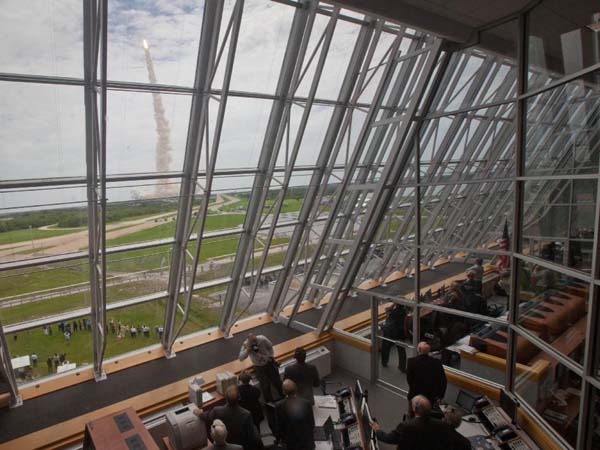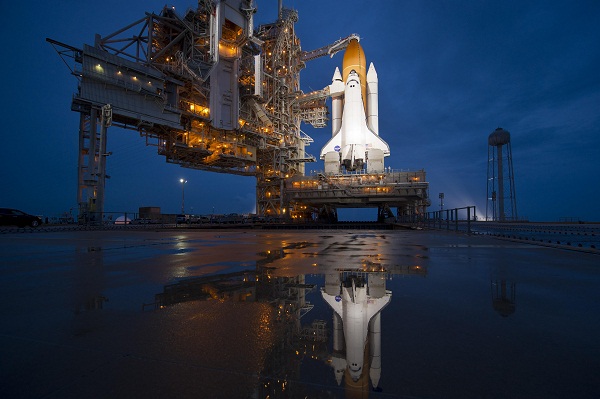|
The four-man crew led by Commander Chris Ferguson
reported all fine shortly after the spacecraft
went into its designated orbit towards rendezvous
with ISS Sunday, July 10 to deliver the Russian-made
multi-purpose logistics module Raffaello, which
contains some 3,500 kg of supplies and hardware
to sustain the ISS. Other members include Pilot
Doug Hurley, and Mission Specialists Sandy Magnus
and Rex Walheim.
A day later, on Saturday, the crew used the robotic
arm to operate onboard high resolution cameras
to inspect the spacecraft’s heat shield,
made of Reinforced Carbon Carbon (RCC) which NASA
said “protects the shuttle from the hottest
temperatures it experiences.” Imagery is
sent to ground control for minute analyses.
With Commander Ferguson at the helm, Atlantis
also did a 9-minute 360 degrees Rendezvous Pitch
Maneuver, or “backflip,” to enable ISS crew members
to take high resolution digital pictures of the
shuttle’s heat shield. Three cameras outfitted
with 1,000 mm, 800 mm and 400 mm lenses captured
photos that provided Mission Control experts with
the best possible imagery to validate the integrity
of Atlantis’ heat shield.
“Imagery experts on the ground comb through
the data (continuously) to ensure that the heat
shield remains in good shape,” NASA said.
Soon after the backflip, on Sunday July 10, Atlantis
docked with ISS.
Commander Ferguson guided Atlantis into the pressurized
mating adapter #2 on the ISS’ Harmony node.
The two spacecraft were flying about 240 miles
high, east of New Zealand, at the time they docked.
This was the 12th and final time Atlantis docked
to the space station. It was the 46th shuttle
docking to a space station, nine to the Russian
Mir station and 37 to the International Space
Station. Atlantis performed seven of the nine
Mir dockings. This was the 86th space shuttle
rendezvous operation and the 164th “proximity
operation” in the history of the Space Shuttle
Program, where a shuttle conducted operations
in close proximity to another spacecraft.
The shuttle crew was to join Expedition 28 Commander
Andrey Borisenko and Flight Engineers Alexander
Samokutyaev and Sergei Volkov of Russia, Satoshi
Furukawa from Japan, and NASA’s Ron Garan
and Mike Fossum.
The combined crew of 10 then begins more than
a week of docked operations, transferring vital
supplies and equipment to sustain station operations.
Once 8,000 pounds of cargo are unloaded from Raffaello,
it will be packed with waste items from the station
and placed back in the cargo bay for return to
Earth.
Atlantis also carries a system to investigate
the potential for robotically refueling existing
satellites and return a failed ammonia pump to
help NASA better understand the failure mechanism
and improve pump designs for future systems.During
the 12-day flight, mission specialists will also
use the shuttle’s robotic arm to lift Raffaello
from the shuttle’s payload bay and hand it
off to the station’s robotic arm for temporary
attachment to the Harmony node segment. Raffaello
contains logistics, supplies and hardware for
transfer to the station.

NASA, or the US National Aeronautics and Space
Administration, observed: “Atlantis and its
four astronauts left Earth for the final space
shuttle mission, which will cap off an amazing
30-year program of exploration, which launched
great observatories, built an International Space
Station, and taught us more about how humans can
live and work in space.”
The historic Final Launch was witnessed by an
estimated one million people camping around the
launch site, in hotels, guest houses or just open
pieces of land.
US aerospace giant Boeing, which builds and manages
the shuttle program, made elaborate arrangements
for its staff and invitees to witness the event
for the last time to give the shuttle program
a farewell after 30 years of dreams, some tears
and great technology feats.
US Air Force (USAF) jets and Homeland Security
helicopters patrolled overhead to secure the area.
Atlantis first flew on 3 Oct 1985, completing
31 missions since then. The current mission is
its 32nd, and the last of what is called the Space
Transportation System (STS). The current mission
is 135th in the series, simply called STS 135.
The first mission, or STS 1, was on 12 Apr 1981
when Space Shuttle Columbia carried two astronauts,
Commander John W Young and Robert L Crippen on
a test flight for more than 54 hours over 37 orbits
at a height of 301 km above and around the earth,
traveling 1,728,000 km before a safe landing.
Unfortunately, Columbia suffered a disaster on
1 Feb 2003 on its 28th mission, NASA designation
STS 107.
All the seven astronauts on board including the
Indian born American Kalpana Chawla – who graduated
from the Punjab Engineering College in Chandigarh
– perished when the shuttle disintegrated just
before concluding the two-week mission. Some of
the heat shield tiles had come off during Columbia’s
takeoff on Jan 16, resulting in the shuttle’s
fiery re-entry and disintegration.
The space shuttle program was sanctioned by the
then President Ronald Reagan. The current US President,
Barack Obama, has ordered it closed and asked
the industry to develop cheaper and technologically
better spacecraft now to service the ISS as also
for the next steps in space exploration, like
going to the Mars in not too distant a future.

Said NASA Administrator Charles Bolden: “With
today's final launch of the space shuttle we turn
the page on a remarkable period in America's history
in space, while beginning the next chapter in
our nation's extraordinary story of exploration.
Tomorrow's destinations will inspire new generations
of explorers, and the shuttle pioneers have made
the next chapter of human spaceflight possible."
Pix: NASA
|